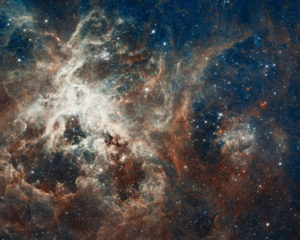I saw this on the Wired Science blogfeed the other day. Sometimes people say that the size of the universe is evidence against the existence of God. The Bible seems to privilege planet earth so much. It seems to only care about our existence, and yet, here is this massive universe, in which we are only one small ball of dirt orbiting an unremarkable star. We’re so small. Surely, the Bible can’t really take all that into account. Surely, if the ancient authors of the Bible knew what we know now, and could see with our telescopes, and could know the probability of there being other inhabited planets with other races of life, they would not have written a book which seems to know only earth, at the center of a Creator’s plans. But just say (we might counter to our unbelieving friend), for a minute, that the Bible is totally true. Say an infinite, intelligent, creative being made the universe. And say that He decided that the skies above the earth would proclaim a certain message. That message, the Bible says, is nothing less than His own glory. That’s what Psalm 19 says. In other words, what kind of universe would we expect to see if an infinite, creative, Artisan wanted to show us how glorious He was? First things first, it would look awesome from earth. Check. But just as important (maybe more important), He would make sure that, when the time came and our technology gave us the ability to see far beyond what our natural eyesight affords, we’d see even more awesome things. Rings. Comets. Galaxies. Nebula. Black Holes. Check. But wait, suppose we could see way, way out there. Wouldn’t an infinite Artisan, wanting to show us how infinite His glory is, need to create something that looks, well, infinite? If we could see the end of the universe, wouldn’t that communicate that His glory was exhaustible? Finite? Even…not that great? So then, of course the universe we see in 2012 through our amazing telescopes looks huge, beautiful, and infinite. Of course we feel small when we peer out into it and contemplate its size. In the face of the glory of the One who dreamed it up and made it, we are small. It would do us good, as a culture, to contemplate our smallness next the the glory of God. Many things would come into focus. For today though, ponder this: 
Millions of young stars shine brightly in this enormous stellar nursery at the heart of the Tarantula Nebula.
The Hubble space telescope captured this amazing panorama, which reveals intricate details about the expanse known as 30 Doradus. Located about 170,000 light-years away in the Large Magellanic Cloud — a small galaxy orbiting our Milky Way — 30 Doradus is one of the largest and most prolific star-forming regions in our galactic neck of the woods.
The region is so huge that, if it were as close to us as the Orion Nebula (the nearest stellar nursery to Earth, about 1,300 light-years away), it would be the size of 60 full moons in the sky and glow so brightly that it could cast shadows on the ground.
Though 30 Doradus isn’t quite that close, Hubble can still resolve the individual stars inside the region, allowing astronomers to study the lives of stars in detail…
The white region in the left side of the picture contains some of the most massive stars in the universe, weighing in at hundreds of times the sun’s mass…
The new image was released Apr. 17 in honor of Hubble’s 22nd year in orbit. You can download the image at 4,000 x 3,200 pixels, but if you want to really zoom in on the picture, download the insanely large 20,323 x 16,259-pixel version. (Warning: It’s 643 MB.)
Image: NASA, ESA, ESO, D. Lennon and E. Sabbi (ESA/STScI), J. Anderson, S. E. de Mink, R. van der Marel, T. Sohn, and N. Walborn (STScI), N. Bastian (Excellence Cluster, Munich), L. Bedin (INAF, Padua), E. Bressert (ESO), P. Crowther (Sheffield), A. de Koter (Amsterdam), C. Evans (UKATC/STFC, Edinburgh), A. Herrero (IAC, Tenerife), N. Langer (AifA, Bonn), I. Platais (JHU) and H. Sana (Amsterdam)
